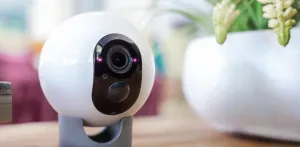The Eye in the Sky: How Motion Detection Cameras Keep Us Safe and Sound
It was just last week when I came home to find a package on my porch—something I wasn't expecting, especially since my online shopping habits had considerably slowed down since my "add-to-cart" phase last month. That’s when I realized someone had tried to hide their own goods by pretending it was a delivery at my doorstep. Talk about sneaky, right? This was the moment I decided to escalate my home security from a simple deadbolt to something a bit more... digital. Cue my deep dive into the world of security cameras with motion detection and alerts.
The upgrade felt like going from an old walkie-talkie to a high-tech command center. I mean, who wouldn't feel a bit like a superhero monitoring their lair? But with great power—or in this case, great technology—comes great responsibility (and a need to actually understand what you’ve got mounted on your wall). So, let’s break it down and see why adding a security camera with motion detection and alerts to your safety arsenal might just be the game changer you’re looking for.
What Can Modern Security Cameras Really Do?
These aren't your grandma’s grainy, can-hardly-see-anything security tapes. Modern security cameras are smarter, sharper, and way more intuitive. Here's how they work: essentially, these cameras are designed to detect any movement within their field of view. When movement is detected, the camera springs into action, recording the event, and typically sending an alert straight to your phone, tablet, or whatever smart device you’re using. It feels a bit like having notifications for your front door—“Ping! Someone’s there.”
The technology behind this isn't just a straightforward video recording. These cameras use a mix of motion sensors, artificial intelligence, and sometimes even machine learning to differentiate between routine movements, like your cat prowling for her midnight snack, and potential threats, like an unknown visitor lurking too long by your car. This level of distinction helps in reducing false alarms—a common headache in earlier systems. (safehome.org) (arcdyn.com) (zoomon.camera)
Curious how this tech is evolving? Check out the latest trends in home security cameras.
Choosing the Right Camera for Your Needs
Picking the right security camera is like choosing the best slice of pizza—there’s no one-size-fits-all option. Believe me, I learned that the hard way when I installed a camera that kept sending me alerts every time my neighbor's dog decided to chase his tail by my fence. Here’s what I wish I knew before diving in:
- Video Quality: Look for cameras that offer at least 1080p resolution. This ensures the footage is clear enough to see details, which can be crucial for identifying faces or license plate numbers.
- Field of View: This determines how wide an area your camera covers. A wider field of view means fewer blind spots but can sometimes result in a less detailed image for distant objects.
- Night Vision: Essential for all the night owls out there and anyone wanting round-the-clock surveillance. Good night vision capability means clearer images in low light conditions. Learn more about the importance of night vision.
- Storage Options: Some cameras offer cloud storage, which means you can access your video footage anytime and anywhere, while others might use local storage like SD cards. Consider what works best for your privacy and convenience needs.
- Smart Home Integration: If you’re like me and have other smart home devices, find a camera that integrates seamlessly with your existing system for a smoother operation. Here’s how to integrate your security system with smart home platforms.
And perhaps one of the most important features—make sure it has reliable motion detection and prompt alert systems. That’s the whole point, after all.
Installation Tips to Maximize Efficiency
Placing your new camera is not just about choosing a corner and mounting it. It’s about strategic placement and settings. Here’s what you need to know:
- High and Hidden: Place your cameras high enough to avoid tampering and cover the desired area effectively. But, keep it discrete enough not to turn your home into a Big Brother set.
- Test Your Angles: Before finalizing the installation, spend a day or two testing different angles to determine which provides the best coverage without unnecessary alerts.
- Wi-Fi Strength: Ensure your camera location gets a strong Wi-Fi signal. A weak signal can mean dropped connections and missed footage—exactly what you don’t want in a security camera. Here’s a quick guide to connecting wireless cameras to Wi-Fi properly.
- Sensitivity Settings: Take the time to adjust the motion sensitivity settings. This will help minimize alerts from small animals or changing light conditions and focus on real threats.
Additionally, investing in weatherproof models for outside installation will save you a lot of maintenance trouble and unexpected breakdowns—something I learned after my first “not-so-weatherproof” purchase began to malfunction during a typical spring rainstorm.
Privacy Concerns and Legal Implications
With great surveillance power comes great responsibility. Always consider the privacy of your neighbors and adhere to local laws regarding recording in public or shared spaces. It can be a thin line between securing your home and accidentally setting up a surveillance hub that peers a bit too closely into your neighbor's yard. To stay compliant, here's a helpful read on privacy and home security cameras.
For instance, it’s important to position cameras focused only on your property unless you’ve obtained explicit consent from your neighbors. Transparency about the presence of your cameras can also prevent legal headaches in the future and maintain good relations in your community.
Final Thoughts: Enhancing Your Home’s Security
Whether you’re protecting your family, checking in on your pets, or ensuring your parcels don’t walk away, security cameras with motion detection offer a flexible, advanced way to keep an eye on what matters most. For more peace of mind, explore self-monitored camera systems.
They have certainly changed the way I view home security—from my “package incident” to feeling more secure with just a few taps on my smartphone.
Embracing this technology can seem daunting at first, but the peace of mind it offers is invaluable. It’s like giving your home its own set of eyes, always watching, always alert, so that you can relax a bit more. And let’s be honest, who wouldn’t want that extra layer of protection? It might just be the best investment you can make for your home and safety.
So here's to less worrying and more living—securely, of course. Maybe it’s time to give your home the upgrade it deserves. After all, an informed decision is a smart decision!





